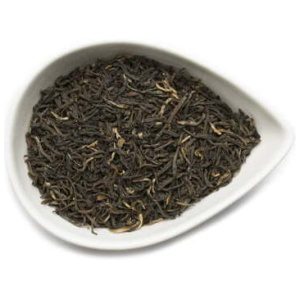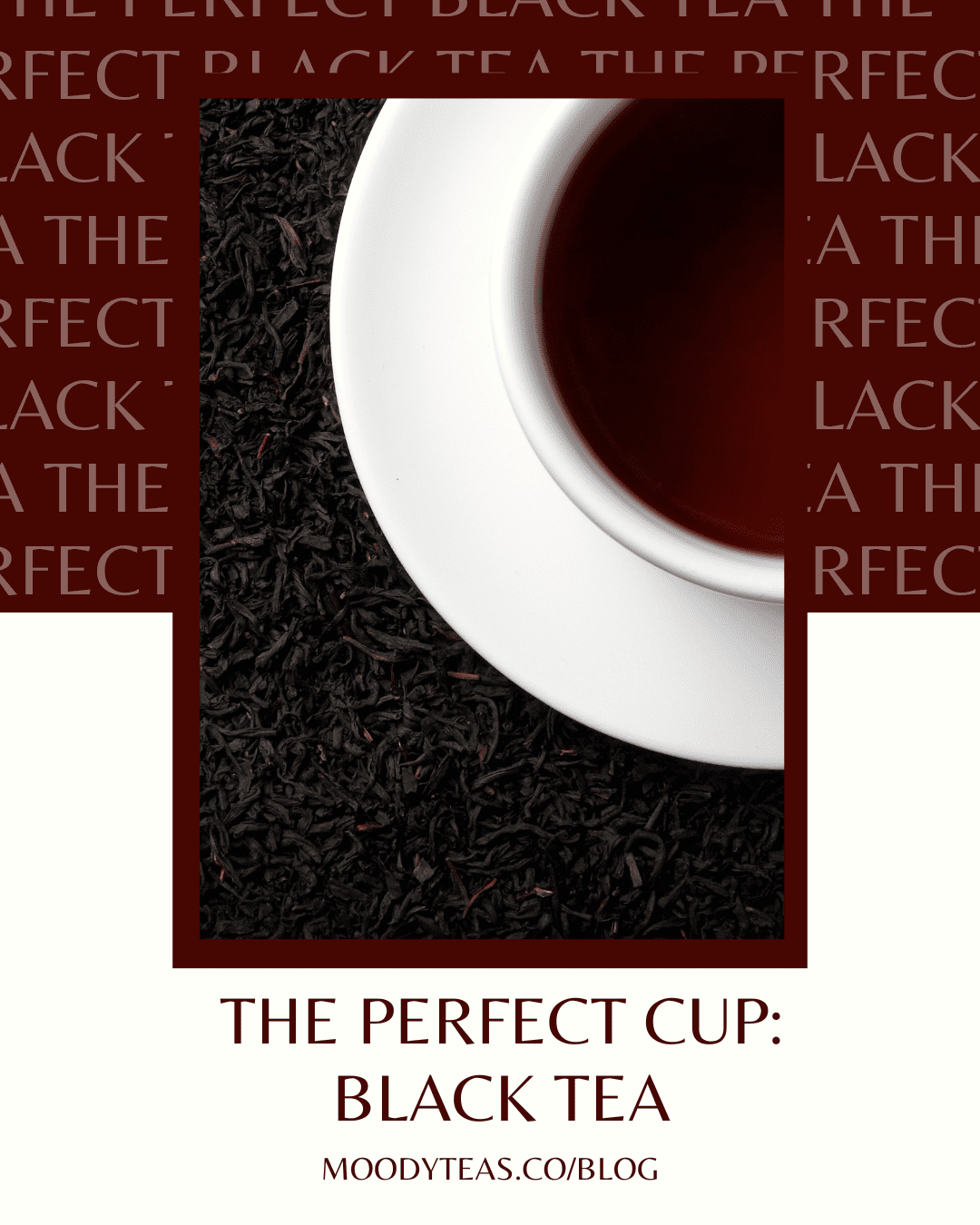It’s Monday, and we’re definitely feeling the hump day vibes. At this point in the week we need a strong cup of black tea. But a bad cup of tea can leave you with a bitter taste in your mouth – literally. So what is black tea and how can you brew the perfect cup?
Black tea is a popular beverage enjoyed by people all over the world – in fact, black teas account for 75% of the worlds teas. It is made from the leaves of the Camellia sinensis plant and is known for its strong flavor and deep color. In this blog post, we will explore the history, making, and drinking of black tea.
History of Black Tea

The history of black tea can be traced back to China, where it was first discovered over 5,000 years ago. According to legend, the Emperor Shennong accidentally discovered tea when a tea leaf fell into his cup of boiling water. The Emperor was impressed by the taste and health benefits of the beverage, and it soon became a popular drink in China.
The first black tea was produced in the 17th century in the Fujian province of China. The process of making black teas involves oxidizing the tea leaves, which gives them their distinct flavor and color. This process was discovered by accident when tea leaves were left out to dry in the sun, and the moisture caused them to oxidize and turn black.
Black tea soon became a popular export from China, and the British began importing it in the 18th century. The British became so enamored with these teas that they began growing it in their own colonies, such as India and Sri Lanka.
Producing Black Teas
The process of making black teas involves several steps. First, the tea leaves are picked by hand or machine. The leaves are then withered, which involves laying them out to dry in the sun or in a heated room. This process removes the moisture from the leaves and prepares them for rolling.
After the withering process, the tea leaves are rolled. Rolling the leaves helps to release their flavor and aroma. The leaves are then oxidized, which involves exposing them to oxygen. This process causes the leaves to turn black and gives them their distinct flavor. Oxidization actually changes the chemical composition of the tea leaves, which is why black teas taste so much different than their green or white counterparts. Finally, the tea leaves are dried to stop the oxidation process. The dried leaves are then sorted, graded, and packaged for sale.
Types of Black Tea
Black tea is enjoyed by people all over the world. It can be served hot or cold and can be enjoyed with or without milk and sugar. Black teas are a diverse category of tea, with a wide range of flavors and styles that vary depending on the region, processing method, and growing conditions. Black teas are also used as a base for many flavored teas, such as Earl Grey and chai.
These are some of the most popular black teas:
- Assam
- Assam is a type of tea that is grown in the Assam region of India. It is known for its strong, full-bodied flavor and malty aroma. Assam tea is commonly used as a base for chai and is often enjoyed with milk and sugar.
- Darjeeling
- Darjeeling is a tea that is grown in the Darjeeling district of West Bengal, India. It is known for its floral and fruity flavor and is often described as the “champagne of teas.” Darjeeling tea is usually enjoyed without milk and has a light, delicate flavor.
- Ceylon
- Ceylon tea, also known as Sri Lankan tea, is grown in Sri Lanka. It is known for its bright, crisp flavor and is often used as a base for iced tea. Ceylon tea is also used in many blends, including Earl Grey.
- Keemun
- Keemun is a tea that is grown in the Anhui province of China. It is known for its fruity and floral flavor and is often described as having a smoky or earthy aroma. Keemun tea is often enjoyed with milk and sugar.
- Lapsang Souchong
- Lapsang Souchong is a tea that is also grown in the Anhui province of China. It is known for its smoky, woody flavor, which is achieved by smoking the tea leaves over pine wood fires. Lapsang Souchong is an acquired taste and is often enjoyed on its own or with savory foods.
- English Breakfast
- English Breakfast is a blend of teas that is often enjoyed in the morning with breakfast. It typically includes Assam, Ceylon, and Kenyan teas and is known for its strong, full-bodied flavor. English Breakfast is often enjoyed with milk and sugar.
- Earl Grey
- Earl Grey is a blend of tea that is flavored with bergamot oil, which gives it a floral and citrusy flavor. Earl Grey is one of the most popular types of flavored tea and is often enjoyed with milk and sugar.
Our Favorite Black Tea – Kumaon Black
Kumaon Black is a type of black tea that is grown in the Kumaon region of the Indian state of Uttarakhand. The Kumaon region is located in the foothills of the Himalayas and is known for its high-altitude tea gardens, which produce some of the finest teas in India. The high altitude, cool climate, and fertile soil of the Kumaon region create ideal growing conditions for the tea plant, resulting in a unique flavor profile that is distinct from other types of black tea.

Kumaon black tea is harvested in the spring and summer months, and the leaves are withered, rolled, oxidized, and dried to produce the final product. The tea has a rich, full-bodied flavor with notes of honey and musk, and a subtle floral aroma. Kumaon Black is known for its smooth, well-rounded taste and is often compared to the finest Darjeeling teas.
Kumaon black tea is typically enjoyed on its own or with a splash of milk and sugar. It is also used in blends, including chai and Earl Grey. The tea is considered to be a luxury product, and its production is limited, making it highly sought after by tea connoisseurs and enthusiasts.
In recent years, the Kumaon region has become known for its organic and biodynamic farming practices, which prioritize sustainability and environmental responsibility. This approach to tea farming has led to the production of high-quality, pesticide-free teas that are in demand around the world.
Kumaon Black is a unique and high-quality black tea that is grown in the Kumaon region of India. Its rich flavor and smooth taste make it a favorite among tea enthusiasts, and its limited production and sustainable farming practices make it a valuable and sought-after commodity. If you are a fan of black tea, be sure to try Kumaon Black and experience its unique flavor profile for yourself.
Health Benefits of Black Tea
There are many health benefits associated with drinking tea. Black teas contains antioxidants, which can help to protect the body against damage from free radicals. It also contains caffeine, which can help to improve mental alertness and focus. It may help to reduce the risk of heart disease, lower blood pressure, improve cholesterol levels, improve digestion and boost the immune system.
Here are some of the potential benefits of drinking that cup of black tea:
- Improved heart health: Studies have shown that drinking black tea can improve cardiovascular health by reducing the risk of heart disease and stroke. The antioxidants in tea may help to reduce inflammation and improve the health of blood vessels.
- Lowered cholesterol levels: Drinking black tea may also help to lower LDL (bad) cholesterol levels in the blood. This could help to reduce the risk of heart disease and stroke.
- Increased mental alertness: Tea contains caffeine, which can help to improve mental alertness and concentration. It may also help to improve mood and reduce stress.
- Improved gut health: The polyphenols in tea may also have a positive effect on gut health by promoting the growth of beneficial gut bacteria.
- Reduced risk of cancer: Some studies have suggested that drinking black tea may be associated with a reduced risk of certain types of cancer, including breast, ovarian, and lung cancer.
- Better bone health: Drinking black tea may also help to improve bone density and reduce the risk of osteoporosis, especially in postmenopausal women.
It’s worth noting that while these potential health benefits are promising, more research is needed to fully understand the effects of black tea on human health. Additionally, consuming large amounts of tea (more than 5 cups per day) may have negative side effects, such as increased risk of kidney stones or disrupted iron absorption. As with any beverage, moderation is key.
Brewing Black Tea
The best way to brew tea can depend on the type you are using, as well as personal taste preferences. However, there are some general guidelines that can help you make a delicious cup of black tea.
- Start with high-quality tea. To brew a delicious cup of black tea, it is important to start with high-quality tea. Look for tea that is fresh, whole-leaf, and has been properly stored to ensure that it retains its flavor and aroma.
- Use fresh, clean water. The quality of the water you use can have a big impact on the flavor of your tea. Use fresh, clean water that has not been over-boiled or left sitting for too long. It is also important to avoid using water that has a strong taste or odor, such as water that has been treated with chlorine.
- Choose the right temperature. Different types of tea require different brewing temperatures. As a general rule, black teas should be brewed with water that is just off the boil, around 200-212°F (93-100°C). However, some more delicate leaves, such as Darjeeling, may require a lower temperature, closer to 180-190°F (82-88°C).
- Steep for the right amount of time. The amount of time you steep your black tea can also affect its flavor. As a general rule, black teas should be steeped for 3-5 minutes, depending on the strength of the tea and personal taste preferences. Over-steeping can result in a bitter, astringent flavor, while under-steeping can result in a weak, insipid flavor.
- Add milk and/or sweeteners (optional). While black tea can be enjoyed on its own, many people prefer to add milk, cream, or sweeteners such as sugar, honey, or stevia. The amount of milk and sweeteners you use can vary depending on personal taste preferences.
- Experiment with brewing methods. There are many different methods for brewing tea, including using a tea pot, a French press, or a tea infuser. Experiment with different brewing methods to find the one that works best for you.
The best way to brew black tea can vary depending on personal taste preferences and the type you are using. However, by using high-quality tea, fresh, clean water, the right temperature, and steeping for the right amount of time, you can ensure that your cup of tea is flavorful and delicious.
So, we’ve learned that black tea is a popular and delicious beverage enjoyed by people all over the world. Its history can be traced back to China, where it was first discovered over 5,000 years ago. The process of making this tea involves several steps, including withering, rolling, oxidizing, and drying.
Now, black tea is a diverse category of tea with a wide range of flavors and styles. Whether you prefer a strong, full-bodied tea or a light, delicate tea, there is a type to suit your taste. Black tea can be enjoyed hot or cold and can be served with or without milk and sugar. It is also believed to have a number of health benefits, making it a great addition to any diet. From Assam to Earl Grey, each type of tea has its own unique flavor profile and history. So why not try a few different types of black tea and discover your new favorite?
